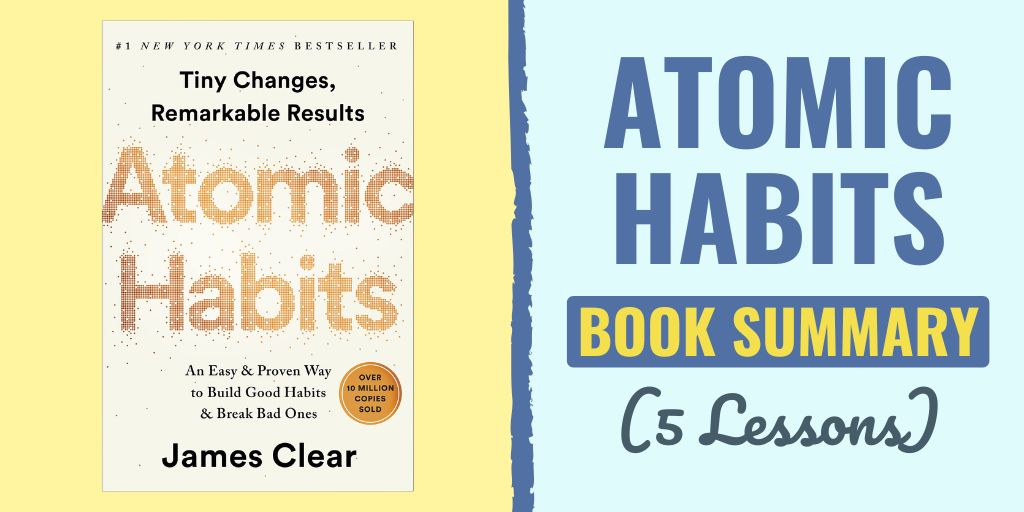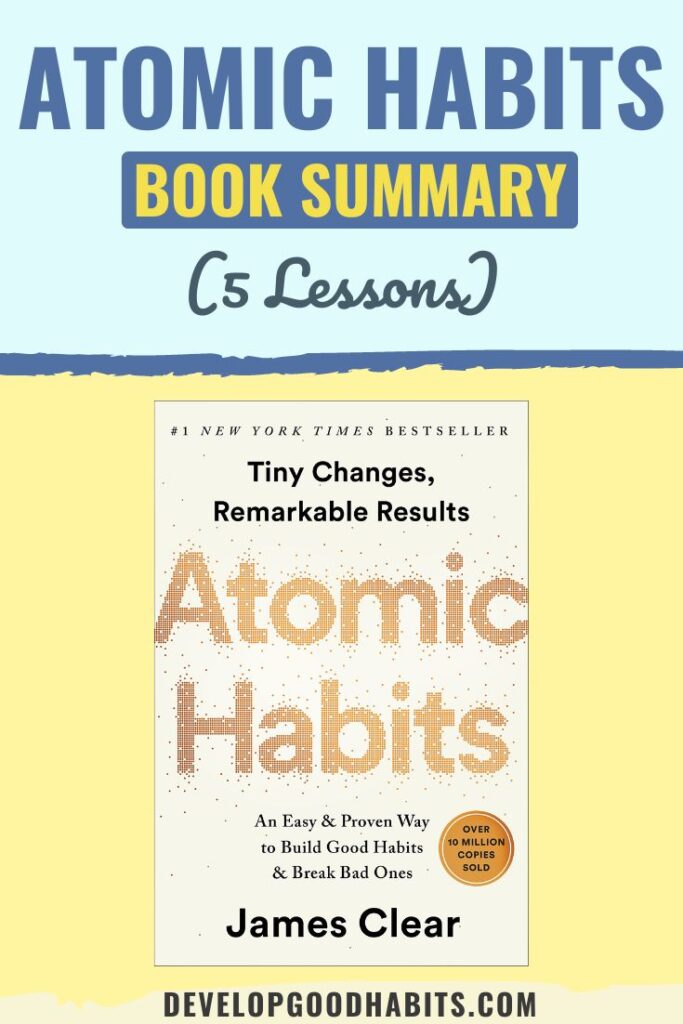There might be affiliate links on this page, which means we get a small commission of anything you buy. As an Amazon Associate we earn from qualifying purchases. Please do your own research before making any online purchase.
Want a simple blueprint for building long-term habits?
If so, then one of the best books you can read is the #1 bestselling book, Atomic Habits by James Clear.
Atomic Habits is about understanding the power of small, incremental changes over time.
The practical techniques here are backed up by scientific research and can create significant changes in your life.
The book not only challenges the way you think about habits but also provides practical solutions to overcome the obstacles that could be holding you back.
In this article, we'll share five simple lessons from the book that you can apply immediately to your life.
Now, if you’d like to check out the book, you can read it on your Kindle, get a print copy, or listen to the audiobook.
Or, if you prefer to watch instead of read, here's the video version of this article:
Let’s begin this exploration into Atomic Habits with…
Lesson #1: Understand the Four Laws of Behavior Change
The first lesson from Atomic Habits is to understand what drives behavior.
Have you ever decided to improve your life, but then find yourself losing motivation after a few weeks or months?
This section will explain why.
Starting with the first law.
Law Number 1: Make It Obvious
If you want to change your behavior or habits, the first thing you need to do is make that obvious.
What does this mean?
If you wanted to start working out, but all your gym clothes were hidden away at the bottom of your wardrobe, does that make you more or less likely to go to the gym?
In most cases, I’d wager the answer will be less.
On the other hand, if you place your gym clothes next to your bed, and it’s the first thing you see when you wake up, you’re going to vastly improve your chances of developing this habit.
Making habit formation “obvious” is all about paying attention to your environment and looking for cues that trigger wanted or unwanted behaviors.
To learn more about this concept, check out our video about the 20-second rule.
Law Number 2: Make It Attractive
A habit has to be appealing for you to make the effort to develop it.
The more appealing a habit is, the more likely you are to either foster a positive habit or replace a positive habit with a negative habit.
One way of doing this is to use techniques like temptation bundling, where you pair a habit you need to do with something you want to do.
For example, you can listen to your favorite podcast while doing chores or exercise.
Anything that makes you want to engage in positive behavior will help you develop the habit.
Law Number 3: Make It Easy
If you want to change habits or develop positive habits, you need to make it as easy on yourself as possible.
You can make things as easy as possible for yourself by doing the following:
Now, let’s look at…
Law Number 4: Make It Satisfying
Finally, and importantly if you want habit change to stick, it needs to feel rewarding.
For example, you can treat yourself to a little reward, like a healthy snack or an extra episode of your favorite show, after a productive day of work or exercise.
Lesson #2: The Fundamentals of Habit Formation
Habit formation is a process that has been researched thoroughly, and we understand what the different steps are that build both positive and negative habits.

Understanding these principles will allow you more control over your behavior.
There are four stages to habit formation, and these are:
Let’s begin with Cues:
Cues
The cue is the trigger that initiates a habit.
It can be anything from a specific time of day, a location, or an emotional state.
By recognizing the cues that initiate your habits, you can start to control and change them.
For example, putting the book you want to read next to your bedside light will vastly increase the chances of developing a reading habit.
Craving
Craving is the desire or motivation that drives you to perform the habit.
Understanding the cravings behind your habits can help you change them.
For example, if you're trying to exercise more, you might associate exercise with a feeling of accomplishment or stress relief.
The great thing about cravings is that they can be influenced by self-talk.
Response
The response is the actual action or behavior that defines the habit.
It's the act of performing the habit in response to the cue and craving.
If you want to use this to create a new habit, focus on making the response easier or more rewarding.
You can do this by breaking down the response into smaller, simpler steps that you can gradually improve over time.
For example, if you want to eat healthier, make unhealthy foods much harder to get to.
It may seem ridiculous, but it works.
Finally, let’s look at…
Reward
The reward is the outcome or benefit you receive from performing the habit. It’s crucial to habit-forming because it’s what makes these habits stick around.
When trying to create good habits, ensure you have a meaningful and immediate reward associated with them.
This will help reinforce the habit and make it more likely to stick.
Understanding Cues, Cravings, Responses, and Rewards is the key to cultivating habits that work for you instead of against you.
But what about breaking bad habits?
Lesson #3: How to Break Bad Habits
Creating positive habits is one thing, but equally important is learning how to break the bad ones.
In this section, we will discuss the process to follow to banish your negative habits as outlined in Atomic Habits.

To break bad habits, you need to do the opposite of the Four Laws of Behavior Change that we talked about earlier.
Let’s see what this looks like in practice…
Law Number 1: Make it Invisible
When creating good habits, you want to make things as obvious as possible.
When eliminating bad habits, you want to do the complete opposite.
Remove the triggers or cues that remind you of the bad habit.
By making the habit “invisible” you reduce the chances of being tempted.
For example, if you want to quit eating junk food, remove all “trigger foods” from your house.
Law Number 2: Make it Unattractive
Focus on the negative aspects of the habit and visualize the long-term consequences.
This can help make the habit less desirable. In the case of quitting junk food, remind yourself of the health issues it can cause.
Read about the health issues that obese people face or imagine your future if you carry on eating too much unhealthy food.
Law Number 3: Make it Difficult
Add obstacles that make it harder for you to perform the bad habit.
For example, if you want to stop using your phone excessively, place it in another room or use an app that limits your screen time. To learn more, watch our video about the 5 reasons to stop using your phone as an alarm clock.
Law Number 4: Make it Unsatisfying
Find ways to associate the bad habit with negative outcomes, so that you feel less rewarded when you engage in it.
For example, to quit smoking, you might put aside the money you would have spent on cigarettes and see how much you save over time
Remember, breaking bad habits takes time, and it's essential to be patient with yourself.
These are the basic habit mastery skills, but there are a couple more advanced tools to learn.
Lesson #4: Advanced Techniques to Build Habits
In Atomic Habits, James Clear shows us some even more techniques to help stack the odds in your favor.
Here are three powerful and advanced techniques to skyrocket your progress:
Technique 1: Habit Stacking
Habit stacking involves combining a new habit with an existing routine or habit.
Here’s how you do it:
Step 1: Identify a habit you already do consistently.
Step 2: Choose a new habit you want to incorporate into your routine.
Step 3: Create a link between the existing habit and the new habit by performing them together or sequentially.
For example, if you wanted to get into the habit of daily exercising, you could find ways to incorporate exercise into your daily routine.
This connection helps make the new habit stick and become part of your routine.
Technique 2: The Two-Minute Rule
The basic idea is to break down a task into something that you’ll finish within two minutes.

This lets you practice a habit without feeling overwhelmed.
Here are some examples:
Technique 3: Design Your Environment
The idea behind this technique is to set up your surroundings to make it easier to engage in your desired habit and harder to fall into bad habits.
Here are a few strategies for effective environment design:
By designing an environment that supports your goals, your habits will become more natural and sustainable.
Now, let’s tie everything together with…
Lesson #5: Tracking Habits and Measuring Progress
There are all kinds of things you can do to track your progress.
Tracking and measuring are important because it’s what gives you the motivation to stick with things over the long term.
Here are some methods you can use to accomplish this:
- Pen and paper: This old-school method is simple and reliable. Make a mark for each day you complete the habit. You can use a habit tracker as a fun way to measure your progress and make sure you don't fall off the wagon. (We’ll link to a specific habit tracker in the show notes of this video.)
- Spreadsheets: If you prefer digital tracking, create a spreadsheet to monitor your habits. You can input the same data you would put in a paper habit tracker, but a spreadsheet allows you to manipulate the data and visualize your progress more easily.
- Apps: Plenty of habit-tracking apps exist that can help you cultivate positive behaviors. These apps often come with built-in reminders and other features that promote consistency and help you stay accountable.
Habitica and Strides are fantastic apps for this purpose.
Remember to keep it simple and choose a method that best fits your circumstances.
Final Thoughts on James Clear’s Atomic Habits
There are tons of lessons to be learned from James Clear’s Atomic Habits.
Now, as a reminder, if you’d like to check out the book, here are the links:
And if you want to take immediate action on what you’ve learned, then check out our video about the 9-step process for building habits that stick.
And if you're looking for more resources on habits, be sure to check out these blog posts:
- 11 Keystone Habits Examples to Change Your Life
- 14 Best Books on Learning and Building Great Study Habits
- 19 Habits to Let Go of the Past & Live in the Present Moment
Finally, if you need help with building habits, then check out this nine-step blueprint that walks you through the entire process of creating lifelong habits.)



